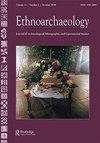Occupancy and the Use of Household Space Among the Dukha
IF 1.3
0 ARCHAEOLOGY
引用次数: 4
Abstract
ABSTRACT Archaeologists commonly encounter the occupation surfaces of ephemeral prehistoric houses. Within those spaces, artifacts can exhibit considerable spatial structure raising the question of what that structure can tell us about human behavior. We explore a simple site-formation model in which household occupancy, defined here as the average number of individuals who simultaneously occupy a house, positively predicts artifact dispersion. We confront the model with ethnographic observations on the use of space in 19 houses inhabited by Dukha reindeer herders of the Mongolian Taiga. The analysis shows that average occupancy predicts dispersion in the use of household space but that systemic noise, sampling error, and event mixing are likely to overwhelm the behavioral signal. Other factors may therefore be equally or more important in driving the spatial dispersion of household artifacts. The study further suggests an analytical framework for exploring relationships between behavior and archaeological structure using ethnoarchaeological data.Dukha的居住和家庭空间的使用
考古学家经常会遇到短暂的史前房屋的占用面。在这些空间中,人工制品可以展示出相当大的空间结构,提出了一个问题,即这种结构可以告诉我们关于人类行为的什么。我们探索了一个简单的地点形成模型,在这个模型中,家庭占用率(这里定义为同时占用一所房子的平均人数)正预测着人工制品的分散。我们将该模型与蒙古针叶林中Dukha驯鹿牧民居住的19所房屋的空间使用情况进行了民族志观察。分析表明,平均入住率预测了家庭空间使用的分散,但系统噪声、抽样误差和事件混合可能会压倒行为信号。因此,其他因素在推动家庭人工制品的空间分散方面可能同样或更重要。该研究进一步提出了一个利用民族考古数据探索行为与考古结构之间关系的分析框架。
本文章由计算机程序翻译,如有差异,请以英文原文为准。
求助全文
约1分钟内获得全文
求助全文
来源期刊

Ethnoarchaeology
ARCHAEOLOGY-
CiteScore
1.60
自引率
0.00%
发文量
10
期刊介绍:
Ethnoarchaeology, a cross-cultural peer-reviewed journal, focuses on the present position, impact of, and future prospects of ethnoarchaeological and experimental studies approaches to anthropological research. The primary goal of this journal is to provide practitioners with an intellectual platform to showcase and appraise current research and theoretical and methodological directions for the 21st century. Although there has been an exponential increase in ethnoarchaeological and experimental research in the past thirty years, there is little that unifies or defines our subdiscipline. Ethnoarchaeology addresses this need, exploring what distinguishes ethnoarchaeological and experimental approaches, what methods connect practitioners, and what unique suite of research attributes we contribute to the better understanding of the human condition. In addition to research articles, the journal publishes book and other media reviews, periodic theme issues, and position statements by noted scholars.
 求助内容:
求助内容: 应助结果提醒方式:
应助结果提醒方式:


